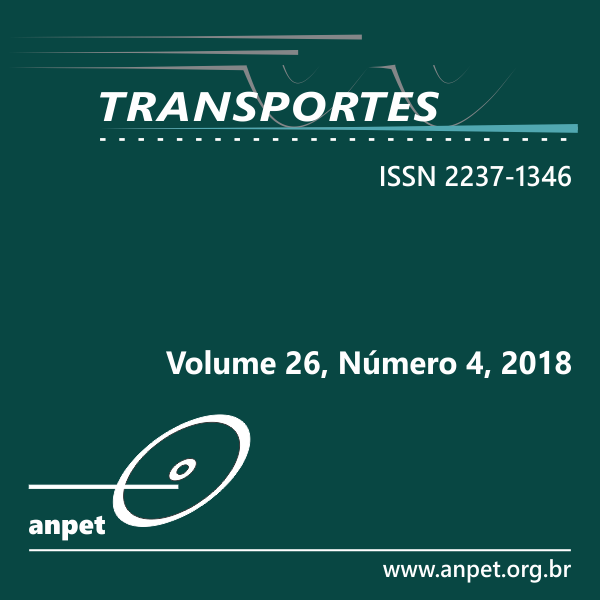Avaliação da relação entre variação de espessura da placa de concreto e presença de defeitos em pavimentos de concreto
DOI:
https://doi.org/10.14295/transportes.v26i4.1441Keywords:
Pavimento de concreto, Espessura de placa, Defeitos, Variabilidade de espessura, Uniformidade de construção.Abstract
A espessura da placa de concreto é a principal incógnita de métodos de dimensionamento de pavimentos de concreto. Pressupõe-se que para condições semelhantes, pavimentos com placas espessas apresentem melhor desempenho do que aqueles com placas delgadas. Entretanto, o efeito da variabilidade da espessura final é pouco discutido. Neste artigo, foram relacionadas informações de avaliações acerca da variabilidade de espessura de pavimentos de concreto com mapas de defeitos na superfície das mesmas placas. Observou-se uma grande variação da espessura do pavimento em ambas as direções. No entanto, o desempenho dos pavimentos (número de defeitos) não depende unicamente da relação entre a espessura de campo e a de projeto. Seções com placas mais espessas do que a espessura de projeto não obtiveram, necessariamente, os melhores desempenhos. Isso se torna importante, considerando que construtoras tendem a construir placas ligeiramente mais espessas, destinadas a evitar deduções de contrato e penalidades. Por outro lado, seções com pequenas deficiências, mas com menor variação de espessura apresentaram um menor número de defeitos, sugerindo o desvio-padrão da espessura (uniformidade de construção) como um parâmetro relevante para o controle de qualidade.
Downloads
References
DNIT (2004) Pavimento Rígido – Execução de pavimento rígido com equipamento de fôrmas-deslizante – Especificação de serviço. DNIT 049/2004-ES. Departamento Nacional de Infraestrutura de Transportes.
EDWARDS, L (2012) Evaluation of Technologies for Nondestructively Determining Concrete Pavement Thickness. Proceedings of the 10th International Conference on Concrete Pavement, ISCP, Québec City, Canada.
FHWA (2003). Distress Identification Manual for Long-Term Pavement Performance Program, FHWA-RD-03-031. US Department of Transportation, Federal Highway Administration.
HOEGH, K.; KHAZANOVICH, L.; YU, T (2011) Ultrasonic Tomography for Evaluation of Concrete Pavements. Transportation Research Record, v. 2232, p. 85 – 94. DOI: 10.3141/2232-09
HOEGH, K.; KHAZANOVICH, L.; YU, T. (2012). Concrete Pavement Joint Diagnostics with Ultrasonic Tomography. Transportation Research Record, v. 2305, p. 54 – 61. DOI: 10.3141/2305-06
HOEGH, K.; KHAZANOVICH, L.; WOREL, B. J.; YU, T. (2013). Detection of Subsurface Joint Deterioration Blind Test Comparison of Ultrasound Array Technology with Conventional Nondestructive Methods. Transportation Research Record, v. 2367, p. 3 – 12. DOI: 10.3141/2367-01
JIANG, Y., SELEZNEVA, O., MLADENOVIC, G., AREF, S., and DARTER, M (2003). Estimation of Pavement Layer Thickness Variability for Reliability-Based Design. Transportation Research Record. 1849, pp. 156-65. DOI: 10.3141/1849-17
KIM, S. M., MCCULLOUGH, B. F (2002). Reconsideration of Thickness Tolerance for Concrete Pavements. Report No. 4382-1, Federal Highway Administration, Washington, DC.
MnDOT (2011). Pavement Distress Identification Manual. Minnesota: Department of Transportation, St. Paul.
MNDOT (2015). Standard Specifications for Construction: 2016 Edition. Minnesota: Department of Transportation, St. Paul.
MnDOT (2006). An Overview of Mn/DOT’s Pavement Condition Rating Procedures and Indices. Minnesota: Department of Transportation St. Paul.
NCHRP (2004). Guide for Mechanistic-Empirical Design of new and rehabilitated pavement structures, final report, part 3. Design Analysis, chapter 4. Design of new and reconstructed rigid pavements, Illinois, ERES Consultants Division.
PACKARD, R. G. e TAYABJI, S. D (1985). New PCA thickness design procedure for concrete highway and street pavements. 3th International Conference on Concrete Pavement Desgin. Proceedings. Purdue University. pp. 225-236. West Lafayette.
SALLES, L. S., BALBO, J. T. e KHAZANOVICH, L. Non-destructive ultrasonic tomography for concrete pavement evaluation: signal processing and image analysis of crucial parameters. Revista Ibracon de Estruturas e Materiais, v. 10, p. 1182-1191, 2017. DOI: 10.1590/s1983-41952017000600004
STUBSTAD, R. N., TAYABJI, S. D., LUKANEN, E. O. (2002). LTPP Data Analysis: Variations in Pavement Design Inputs. Report No. Project 20-50[5]), National Cooperative Highway Research Program Transportation Research Board National Research Council, Washington, DC.
VANCURA, M., KHAZANOVICH, L., BARNES, R (2013). Variation Assessment with Cores and Nondestructive Testing Measurements. Transportation Research Record, v. 2347, p. 61 – 68. DOI: 10.3141/2347-07
Downloads
Published
How to Cite
Issue
Section
License
Authors who submit papers for publication by TRANSPORTES agree to the following terms:
- The authors retain the copyright and grant Transportes the right of first publication of the manuscript, without any financial charge, and waive any other remuneration for its publication by ANPET.
- Upon publication by Transportes, the manuscript is automatically licensed under the Creative Commons License CC BY 4.0 license. This license permits the work to be shared with proper attribution to the authors and its original publication in this journal.
- Authors are authorized to enter into additional separate contracts for the non-exclusive distribution of the version of the manuscript published in this journal (e.g., publishing in an institutional repository or as a book chapter), with recognition of the initial publication in this journal, provided that such a contract does not imply an endorsement of the content of the manuscript or the new medium by ANPET.
- Authors are permitted and encouraged to publish and distribute their work online (e.g., in institutional repositories or on their personal websites) after the editorial process is complete. As Transportes provides open access to all published issues, authors are encouraged to use links to the DOI of their article in these cases.
- Authors guarantee that they have obtained the necessary authorization from their employers for the transfer of rights under this agreement, if these employers hold any copyright over the manuscript. Additionally, authors assume all responsibility for any copyright infringements by these employers, releasing ANPET and Transportes from any responsibility in this regard.
- Authors assume full responsibility for the content of the manuscript, including the necessary and appropriate authorizations for the disclosure of collected data and obtained results, releasing ANPET and Transportes from any responsibility in this regard.









